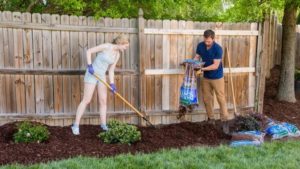 Whether you have cats or dogs — or maybe both — in your house, you want to keep them safe, healthy and happy. And your home extends to your yard. It is important to consider the common hazards to pets outside your home and learn what you can do to make your yard safe. Following are ideas to get you started.
Whether you have cats or dogs — or maybe both — in your house, you want to keep them safe, healthy and happy. And your home extends to your yard. It is important to consider the common hazards to pets outside your home and learn what you can do to make your yard safe. Following are ideas to get you started.
Remove Dangerous Tools
Dogs can be curious and can easily get into the tools you leave out in the yard. Make a space to properly store items that you would use for gardening or lawn maintenance so that your dogs can stay safe. Keeping these tools in a shed, garage or basement is a good first step.
Avoid Toxic Plants
Many plants are toxic to dogs and cats. Avoid planting these plants where your pets might decide to snack on them. Some popular but dangerous plants include the following:
- Lilies
- Begonia
- Chrysanthemum
- Daffodil
- Iris
- English ivy
Check with your local nursery to identify plants that are safe for your pets.
Remove the Dangers of Fleas and Ticks
Fleas and ticks pose a dangerous health threat to your dogs and cats. Make sure your pet is on a preventative medication if they will be outside. You also can restrict the habitats for fleas and ticks by removing long or dry grasses and keeping the lawn well maintained.
Install a Fence
The surrounding neighborhood also can pose hazards. Cars, other dogs and even some humans can pose additional threats to your pets. Installing a fence can give your dogs a place to exercise without the dangers of escaping or getting lost.
Build a Catio
The safest place for a cat may be indoors. But if you want to give your cats an outdoor experience, consider building a catio. This is a completely enclosed outdoor structure with plenty of places to climb that will enrich your cat’s experience while also keeping them safe from predatory animals, cars and feline diseases.
If you and your furry friends are looking for a new home, call us today.






